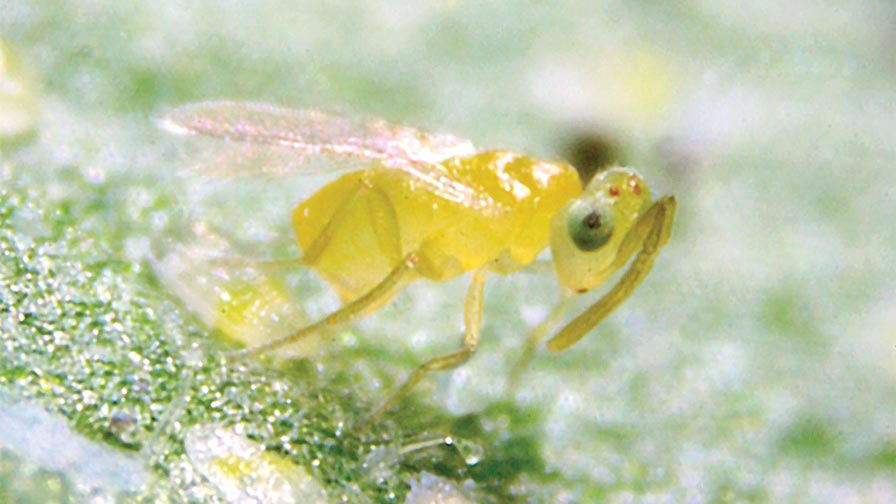Beneficial Predators Can Help Control Whiteflies On Poinsettia

The parasitic wasp Eretmocerus eremicus is a foundational biocontrol necessary to curb whiteflies on poinsettia. It is offered in blister packs or shipped in vials as parasitized pupae.
Greenhouse growers and whiteflies on poinsettia could be compared to children and Santa Claus at Christmas: Each can’t conceivably imagine the season without the other. Two main species of whitefly are associated with poinsettias: The greenhouse whitefly (GHWF, Trialeurodes vaporariorum), and the silverleaf whitefly (SLWF, Bemisia argentifolii).
Currently, the predominant species is the Bemisia whitefly, which occurs in two forms: B and Q biotypes. These biotypes are genetically different. Evidence reveals that some chemistries are ineffective against the Q biotype, making recommendations to growers with the Q biotype more challenging. Pesticide resistance against whitefly on poinsettia is a common issue.
Add Biological Control Agents To Your Pest Control Arsenal
Many growers are reporting success with integrating total plant management practices, including use of biological control agents (BCAs), into a poinsettia whitefly program. Some keys to ensure success include:
• Sanitation within and outside a greenhouse (e.g., reduce weeds that host the whitefly)
• Exclusion of the pests via insect screening or isolating new cuttings prior to placing inside greenhouse
• Monitoring for whitefly via weekly scouting to determine the species present, recording the life stage, and noting varieties affected. Use of yellow sticky cards at a minimum of 1/1,000 square feet, though use is more effective at 1/250 square feet to determine threshold.
Know Which Parasitoid Wasp Is Right For You
The basis of a biocontrol program for poinsettia begins with the parasitoid wasp, Eretmocerus eremicus. Eretmocerus will control the greenhouse whitefly and the silverleaf whitefly, making it easy for the grower who’s unsure of which species is present. A different parasitoid wasp, Encarsia formosa, parasitizes only the greenhouse whitefly. Another advantage of the Eretmocerus is that parasitized whitefly pupae turn a subtle tan color rather than a black color produced by the Encarsia species.
E. eremicus is offered in blister packs or shipped in vials as parasitized pupae. Blister packs improve the viability and vigor of the wasps. One blister pack treats 500 to 1,000 square feet, depending on the pest population pressure. Place the packs early in the crop on the north side or within the canopy where they’ll be shaded. Blister packs should be replaced at four-week intervals while loose pupae/wasps are replaced every week beginning at transplant.
Eretmocerus and Encarsia wasps are available as a mix of parasitized pupae in blister packs with the same release rate as Eretmocerus blister packs. The Encarsia species doesn’t need blister packs and is available as parasitized pupae on cards. Card placement is at one per 1,300 square feet for low pressure or one per 250 to 650 square feet under moderate pressure. Cards should be protected from direct sun, within the plant canopy. Replace cards weekly among the crop.
Consider Predatory Mites For Early Production When Temps Are High
Early in poinsettia production when temperatures are above 80°F, Amblyseius swirskii, a beneficial predatory mite, can be released as a biological control partner to feed on whitefly eggs and immature thrips. Maintaining a humidity of 70% is required for survival and reproduction of these mites.
These mites are available in controlled-release sachets (CRS) or in bulk packaging. CRS are breeding systems that contain a prey mite (food source) to aid in mite reproduction within the sachet. Sachets are placed at 100 per 1,000 square feet or one per plant (mini sachets) as plants are spaced. These should be replaced at two- to four-week intervals. Bulk mites are released by sprinkling the mite carrier onto foliage. Release rates are 5,000 to 10,000 mites per 1,000 square feet, and should be released weekly. These mites become ineffective when temperatures fall below 60°F.
Success With Biological Control Agents
To achieve success with BCAs, the BCAs should be applied preventatively or at the first sighting of a whitefly. Failures associated in using biocontrol to control whitefly are generally associated with two factors: 1) the lack of knowledge of previous pesticide treatments and releasing biologicals into the crop with a toxic residue, 2) the correct BCA not introduced early enough and the whitefly population was too high for success. If a population should build beyond the biological pest’s ability to maintain control, there are compatible pesticide options available to reduce pest populations.
Consult with your supplier for more information. Always read and follow the entire product label. Not all products are labeled for use in all states. Products other than those listed here may also be safe and effective.









